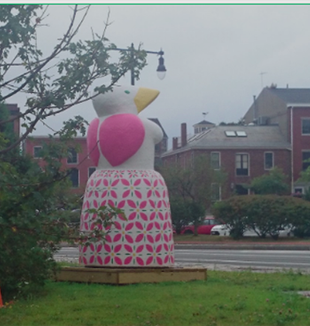
A Protagonist in History
The seagull with human breasts has soulless green eyes which continue to follow me whenever I pass during my commute...The seagull with human breasts has soulless green eyes which continue to follow me whenever I pass during my commute. I am tempted to receive its gaze as condemning, a reminder of my failure to oust it from our Whaling City, home of Herman Melville and Frederick Douglass. But I hold on to my faith that the consequences of my personal crusade are not what defines me nor my efforts. It is a tenuous grasp.
“Seagull Cinderella” always bothered me from the time my children noticed its presence and called out, “look at the duck with boobs!” Nude art can be very beautiful, however, this sculpture struck me as contrived to make a political statement. The statue stood at the forefront of the town, on the public-property intersection of Route 18 and Elm Street, the hub of our depressed city’s minuscule tourism district. That's when I started the petition that went “viral,” from local FM radio to the Boston Globe and New York Magazine.
My attention-grabbing language was a mistake. Breasts had nothing to do with my real problem: I sought to express what was true to me—New Bedford is beautiful and has a quiet depth which is mocked by the fabricated constructs of the seagull-thing. I wanted to give a voice to the many others who had expressed the same. Nonetheless, I was quickly maligned by some feminists; a malignment which I accept. The real storm, though, came from what Globe correspondent Sophie Haigney titled the “obligatory ‘Who cares?’ camp.” I was not wrong because the art was somehow beautiful or powerful. I was to be silenced because I shouldn't care, and because no one should judge art, ever.
The recent judgment “Protagonists of Our Own History” states:
“The apathy that characterizes our time does not originate in the political process, nor does it confine itself to politics. Its source is quite different—we are dealing with a crisis of the person. We seem content watching and commenting, drawing back into our safe spaces, letting history run its course.”
I made many mistakes in this recent course of events—I used imprudent language, engaged in petty squabbles, and lost sight of my initial motivation. But I did do something. This, most of all, challenged the artists and local residents, so unused to venturing out of their protective cocoons. It was an opportunity to act in a time where politics, culture, and history are only settled at the national level, as we observe from afar and “comment on Facebook.”
I tried to be a protagonist of New Bedford, was laughed at like Kierkegaard’s clown, and fell prey, at times, to impulsivity and valuing activism over an expression of Who I follow. The statue still stands, more triumphant than ever; city hall may not even consider my call to reform the exhibit’s curatorial platform. Yet, He is here, providing small graces for me, and as Fr. Rich said at the concluding talk of the Northeast family vacation, He will be there to call me back when tomorrow I again forget.